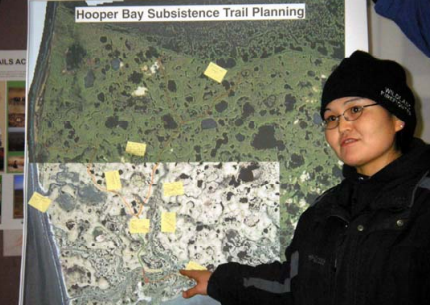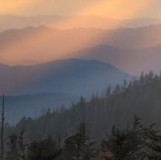
One of the first photographs of the Northern Hawk-Owl at Colville, posted on eBird by Walker Noe.
On December 30, 2015, Dan Waggoner, a bird-watcher, discovered a Northern Hawk-Owl near Brewster, Washington, on the Colville Reservation. A charismatic bird, and very rare south of Canada, the news spread on social media, resulting in a steady flow of birders (as they call themselves) making the four-hour drive from the Seattle area to see and photograph the bird. The owl sometimes perched in a tree along a rural road near a house. The resident of the house, a member of the Confederated Tribes of the Colville Reservation (a conglomeration of twelve tribes), made it clear to the birders that they were not permitted to trespass nor even photograph the owl on his property.
On January 9, 2016, the owl was apparently shot by the resident. Nearby birders, after hearing the gunshot, arrived to find the owl hanging upside down, dead, still clinging to a branch by one foot. Outrage by the birding community was so pronounced that King5 News in Seattle, Indianz.com, and other media outlets covered the story.
 In social media discussions, birders wrote about their anger over a senseless killing, the illegality of it, and the behavior of fellow birders that may or may not have contributed to it. Few made the connection between the shooting of the owl and the fact that the shooter was a tribal member on reservation land.
In social media discussions, birders wrote about their anger over a senseless killing, the illegality of it, and the behavior of fellow birders that may or may not have contributed to it. Few made the connection between the shooting of the owl and the fact that the shooter was a tribal member on reservation land.
The first thing to understand is that reservations are not public land. Technically, they are held in trust by the federal government for tribes, historically to contain Indigenous people and/or protect them from white colonizers, and currently to allow tribes some measure of sovereignty. Tribes need not allow public access (with limited exceptions—primarily roads paid for with state or federal funds). In this case, access was open to the public. Per an agreement with the county, the road was maintained by the county and thus was indeed a public road. Nevertheless, the non-Native public would do well to remember that they are guests and they do not have the same rights to behave as they would in their own neighborhood. Here is a typical guide to etiquette for guests on sovereign tribal land. Rules regarding photography are nearly always included.
 The second thing to understand is that, on reservations, state laws typically do not apply and federal laws only apply because of a Supreme Court ruling that says the United States can unilaterally alter the terms of a treaty with Native tribes any time they want—a ruling greatly resented in Indian Country. This allows the federal government to hold tribes accountable for newer laws passed since the signing of the treaties and establishment of the reservations. Specifically, the applicability of the Migratory Bird Treaty Act (MBTA), which makes killing this bird illegal, has been subject to legal debate since 1941. In this case it is somewhat of a moot point because the reservation itself has their own regulations that mimic the MBTA. The tribe’s laws specifically state, “It shall be unlawful for any Coleville Tribal Member to hunt or kill any eagles, hawks, owls or any other protected species.” The Colville Tribes Department of Fish and Wildlife is investigating the incident. This may or may not make prosecution more likely than it would under the federal MBTA. But the bar is low, for the MBTA is probably the least enforced law in the nation.
The second thing to understand is that, on reservations, state laws typically do not apply and federal laws only apply because of a Supreme Court ruling that says the United States can unilaterally alter the terms of a treaty with Native tribes any time they want—a ruling greatly resented in Indian Country. This allows the federal government to hold tribes accountable for newer laws passed since the signing of the treaties and establishment of the reservations. Specifically, the applicability of the Migratory Bird Treaty Act (MBTA), which makes killing this bird illegal, has been subject to legal debate since 1941. In this case it is somewhat of a moot point because the reservation itself has their own regulations that mimic the MBTA. The tribe’s laws specifically state, “It shall be unlawful for any Coleville Tribal Member to hunt or kill any eagles, hawks, owls or any other protected species.” The Colville Tribes Department of Fish and Wildlife is investigating the incident. This may or may not make prosecution more likely than it would under the federal MBTA. But the bar is low, for the MBTA is probably the least enforced law in the nation.
This legal context may help explain the alleged actions of the resident. While an ornery white rancher is perfectly capable of committing this crime, I suspect, largely because of the context and the peculiar ban on photography, that the shooting of the owl was an act of anger rooted in a desire to make a statement about his rights and sovereignty as a Native on his own land.
I submit this as an explanation, not a justification. The resident lives in a different world from the ambient largely-white society that produced the birders, with a completely different set of experiences and frame of reference. The Colville Reservation has a sordid history from its inception thru the present, with constant battles and lawsuits with the federal government (most recently over federal mismanagement of tribal lands). The reservation is most well-known as the final destination of Chief Joseph and his band of Nez Perce; their descendants live there today. It is no exaggeration to say that the shooter’s people live on the margins of white society, pushed into a backwater bantustan. Perhaps in his mind, the traffic of illegitimate occupiers, traveling a great distance to see a single bird, replete with optics and cameras that cost a good share of the per capita income of the reservation, suggests an opulence shoved in his face, paraded by his house, and stolen from his people. He has control over very little, but he does control the land around his home. So he asserts his sovereignty. He is also playing the nature card, asserting that he, as a Native, knows more about wild animals than urban white liberals, that the hawk-owl population can handle the loss of one individual. Perhaps he hunts and fishes regularly, and thus is used to the taking of animals. Of course, such rationale, if true, was totally lost on the white audience.
While indigenous peoples generally do live close to the land and value sustainable living with the environment, there have been other examples of Natives deliberately shooting birds to screw with visiting white birders. On the Pribilofs in the 1970s, Native teenagers would regularly shoot Asian vagrants (the birding term for species that are otherwise common in Asia but occasionally stray to North America) that birders were seeking, sometimes right in front of the birders. The teens seemed to enjoy having rich white guys at their mercy, shooting the birds as much for amusement as to assert their control over their homeland.

Children working on seabird conservation with the Seabird Youth Network.
That said, it would be wrong to assume that these actions are representative of all of Indian Country. For example, times have changed on the Pribilofs. Native children now participate in the Seabird Youth Network, learning about marine biology and conservation, building nest boxes, and studying the enormous seabird colonies on their islands. In Hooper Bay, Alaska, tribal elders have instituted a program, targeted at their own youth, to minimize disturbance to nesting waterfowl and teach sustainable harvesting. On Haida Gwaii (formerly known as the Queen Charlotte Islands), the Haida Nation has partnered with Parks Canada to eradicate rats to restore Ancient Murrelets. In New Zealand, the Maori have done the same to protect major nesting islands for Sooty Shearwaters, Mottled Petrels, and a host of endemic species. In California, the Yurok are playing an active role in preparing to restore the California Condor to the Northwest Coast.

A tribal community leader discusses conservation of bird nesting areas at Kokechik Flats, Alaska
In fact, Native American tribes in general are involved in environmental battles and restoration efforts across the continent, though a few are considering their own resource extraction endeavors (mostly coal) as a way to earn income. The strongest, most recent example of tribal environmental activism comes from British Columbia, where First Nations (as they are called in Canada) are battling Enbridge over the proposed Northern Gateway Pipeline, which would transport tar sands from the interior to the coast, where it would be shipped to China. As for the Colville tribes, they are actively involved in creek and watershed restoration projects on their reservation that will benefit native fish and plants.
Whatever his rationale, the shooter of the hawk-owl at Colville has little support among many Native Americans, who are largely leaders in battles to protect and restore the environment.


UPDATE: Press release from the tribe:
COLVILLE TRIBES ISSUE CITATION IN RELATION TO KILLING OF NORTHERN HAWK OWL
For Immediate Release
February 9, 2016
NESPELEM, WA – On February 2, 2016, the Colville Confederated Tribes Natural Resource Enforcement concluded its investigation into the killing of a Northern Hawk Owl, located in the Cassimer Bar Area near Brewster, Washington, within the exterior boundaries of the Colville Indian Reservation. The investigation led to issuance of a citation in the amount of $ 5,000.00. The cited individual now has the option of paying the fine, seeking a mitigation hearing, or contesting the citation in Tribal Court. “I am pleased that our office was able to conclude its investigation. It is important that the laws protecting our natural resources be enforced,” said Henry Hix, the Tribe’s Chief of Natural Resources Enforcement. – See more at: http://birding.aba.org/message.php?mesid=1068635&MLID=WA&MLNM=Washington%20Tweeters#sthash.189omHoP.dpuf
Wow. You seriously wrote an entire post trying to explain away the criminal act of killing a protected species of raptor?
Some recent news on Colville Tribes environmental projects, focusing on reintroduction of lynx: https://www.nhonews.com/news/2022/aug/02/washington-tribes-work-reintroducing-wildlife-may-/